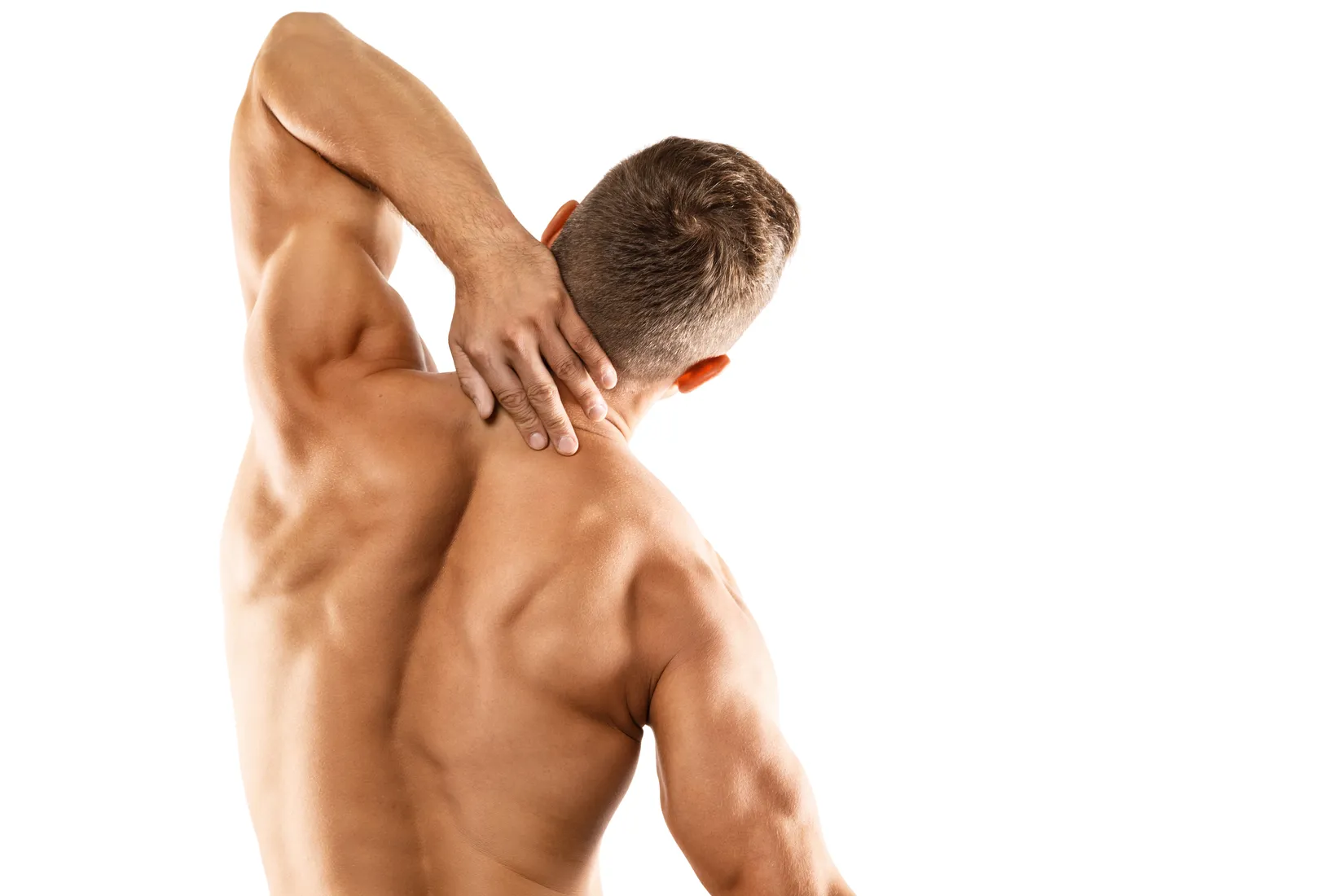Do you have chronic shoulder and neck pain? This widespread condition might hinder your daily life and well-being. Tight shoulder and neck muscles often cause this pain. Rotator cuff injuries, repetitive strain, poor posture, and unexpected impacts can cause muscle stiffness and soreness.
Understanding the causes, such as back and neck pain or muscle stiffness, can help you find relief with physical therapy. Try everyday workouts and stretches to relax your muscles and improve your life.
Understanding Stress-Induced Tension in Shoulders and Neck
Stress and Tense Muscles
Stress often causes severe neck and shoulder pain. It automatically tenses our muscles, particularly the neck and shoulders. Physical therapists usually treat this muscle tightness.
Emotional Impact on Muscle Tension
Emotions can cause shoulder tension and stress. Tense neck and shoulder muscles may indicate anxiety or unease. Mental health affects physical health, especially when combined with bad posture or skills.
Physiological Response to Stress
The body naturally prepares to fight or run in a stressful response, which might tense the neck and shoulder muscles for protection. Hinge Health clients must understand this essential stress response.
Mismanagement of Joint Health
Shoulder strain can result from poor lifestyle choices. Anxious or agitated people may subconsciously clench their jaws or hunch their shoulders. Long-term practices like these can cause muscle tension in Hinge Health clients and others with similar difficulties.
Causes of Tight Shoulders in Hinge Health Clients
Muscular Imbalances
Muscle imbalance causes stiff shoulders. Some muscles become more assertive or faster, causing these inequalities. These discrepancies can strain shoulder joints and tissues. Poor posture, repetitive actions, and shoulder overuse generally cause them.
Repetitive Strain and Overuse
Overuse or repetition might cause shoulder pain in clients. Moving heavy objects, hurling items, or typing for lengthy periods can strain shoulders. Constant tension can tighten and stiffen shoulders. Programs like Hinge Health can help with this stress.
Poor Posture
Poor posture often causes shoulder pain, especially for Hinge Health users. Long durations of floor sitting or poorly constructed desks might cause strain. Slouching or hunching forward puts strain on muscles, causing pain and tightness. Dietary magnesium can improve muscle health and relieve these difficulties.
Lack of Exercise
Tight shoulders can also be caused by not moving around much. Muscles that don’t exercise enough become weaker and less flexible, making the shoulder area stiff and tight. Regular exercise is essential for keeping muscles healthy and avoiding getting tight.
Top Ten Exercises for Relieving Shoulder Tightness
Neck Release
Description and benefits: This easy movement helps to loosen and stretch the tense muscles in the neck and shoulders. It works exceptionally well for people who work at desks or feel tight because of stress.
- Step-by-step guide:
- Sit or stand with a straight spine.
- Slowly tilt your head towards your right shoulder, aiming to touch it with your ear.
- Hold for 5 seconds, feeling the stretch on the left side of your neck.
- Gently return to the center and repeat on the left side.
- Perform five repetitions per side.
Shoulder Rolls
Description and benefits: Shoulder rolls are an easy way to loosen up the upper back and shoulders, warm the shoulder joints, and make them more mobile.
- Step-by-step guide:
- Stand or sit with your back straight.
- Lift your shoulders slowly up towards your ears.
- Roll your shoulders back, bringing them down in a circular motion.
- Complete ten rolls backward, then repeat ten rolls forwards.
Cross-Body Shoulder Stretch
Description and benefits: This stretch works on the deltoids. It can help loosen the back and shoulders while making you more flexible.
- Step-by-step guide:
- Stand with your feet hip-width apart.
- Bring your right arm across your chest.
- Place your left hand on your right elbow, gently pulling your right arm closer to your chest.
- Hold the stretch for 20-30 seconds, then switch sides.
Pendulum Stretch
Description and benefits: This exercise helps make the shoulder joint less stiff and gives it a more excellent range of motion.
- Step-by-step guide:
- Lean forward slightly, supporting yourself with your non-working arm on a table.
- Let your other arm hang freely.
- Gently swing your hanging arm in small circles, gradually increasing the diameter.
- Perform ten circles in each direction before switching arms.
Doorway Stretch
Description and benefits: This stretch can help correct the forward stance caused by sitting. It opens up the chest and shoulders.
- Step-by-step guide:
- Stand in a doorway and raise your arms so your elbows are at a 90-degree angle, with your forearms on the door frame.
- Step through the doorway until you feel a stretch in your chest and shoulders.
- Hold for 20-30 seconds, then gently step back.
Cat-Cow Pose
Description and benefits: This yoga pose makes the spine more flexible and eases stress in the back and neck. Read the complete guide about Cat-Cow Pose.
- Step-by-step guide:
- Start on your hands and knees, with your wrists directly under your shoulders and your knees under your hips.
- Inhale as you arch your back, lifting your head and tailbone towards the ceiling (Cow).
- Exhale as you round your spine, tucking your chin to your chest and drawing your tailbone down (Cat).
- Repeat for ten cycles.
Thread the Needle Pose
Description and benefits: This exercise stretches the shoulders, arms, and upper back, promoting mobility and relief from shoulder tightness.
- Step-by-step guide:
- Start on your hands and knees.
- Slide your right arm underneath your left with your palm facing up.
- Lower your right shoulder to the floor, resting your head on the mat.
- Extend your left arm forward or wrap it behind your back for a deeper stretch.
- Hold for 30 seconds, then switch sides.
Eagle Arms
Description and benefits: This pose stretches the shoulders and upper back, improving circulation and reducing tension.
- Step-by-step guide:
- Stretch your arms straight in front of your body.
- Cross your right arm over your left and bend your elbows.
- Twist your forearms so your palms meet.
- Lift your elbows while dropping your shoulders away from your ears.
- Hold for 15-20 seconds, then switch arms.
ChiChild’sse with Shoulder Variation
Description and benefits: This variation of ChiChild’s helps to relax the body and stretch the shoulders, releasing stress and tension.
- Step-by-step guide:
- Kneel on the floor, touch your big toes together, and sit on your heels.
- Lay your torso down between your thighs and extend your arms forward with palms facing down.
- Walk your hands to the left until you feel a stretch along your right shoulder. Hold for 30 seconds, then walk your hands to the right and repeat.
Wall Stretches
Description and benefits: Wall stretches can help to loosen the chest and shoulder muscles, promoting flexibility and reducing tightness. See these Top-wall yoga exercises.
- Step-by-step guide:
- Stand facing a wall. Extend your right arm and place your palm on the wall at shoulder height.
- Slowly turn your body away from the wall until you feel a stretch in your chest and shoulder.
- Hold for 30 seconds, then switch to the left arm.
Conclusion
This post includes ten powerful shoulder tightness-relieving exercises, from neck releases and shoulder rolls to the doorway stretch and thread the needle position. Regularly doing these exercises can increase shoulder flexibility, reduce pain, and boost your health.
I suggest acting today. Start doing these exercises regularly, even for a few minutes. Continuous progress and shoulder tension management require consistency.
Please comment below if you have shoulder tightness or have done these workouts. Your feedback helps us grow and builds a support network. Feel free to ask questions or need more exercise instructions. We are here to assist! LetLet’sprove shoulder health and comfort together.





